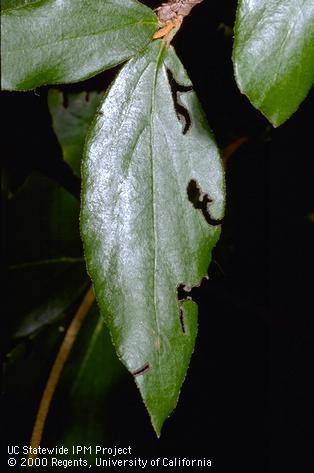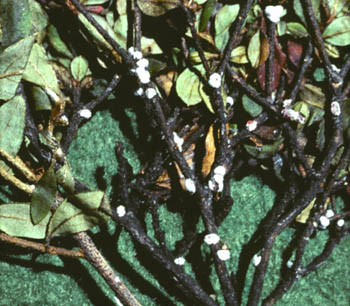Written By: Chad Kuwana, Master Gardener Volunteer Trainee

Credit: University of California Agriculture & Natural Resources
Check back in with your azaleas and rhododendrons this summer!
At this point of the year, summer is in full swing and daily high temperatures are consistently in the upper eighties and nineties. The beautiful spring weather that brought about stunning blooms in your garden is just a memory as you try to beat the heat with some freshly picked berries.
While some spring blooms may be holding on, most azalea and rhododendron bushes have lost their flowers and your attention has likely shifted to other parts of your garden like your fruits and vegetables. However, as you water your plants, you might notice notched edges on the leaves or fuzzy white spots on the branches of your azaleas or rhododendrons. These are signs that black vine weevils or scale might be present on your plants.
Black Vine Weevils – Otiorhynchus sulcatus
Description
Black vine weevils are a type of beetle (Curculionidae) about ½ inch (12.7 mm) long. They cannot fly and are mostly black with small patches of white. The larvae are also about ½ inch (1.27 cm) long but are white with a brown head. Adult black vine weevils eat foliage and are most active at night. You will notice notches in leaves from where they were feeding. Larvae, however, feed on the roots of your azalea or rhododendron, so they can cause more severe damage to your plant as it can lead to diseases like Phytophthora root rot.

Credit: University of California Agriculture & Natural Resources
Life Cycle
The reason you might be noticing evidence of their presence in July and early August is because of their life cycle. Black vine weevils usually emerge between May and June after overwintering in their larvae stage. Upon emerging they need anywhere between 21 and 28 days of feeding before they are ready to lay eggs and begin a new generation. Thus, peak adult populations are seen in the summer. Once they are ready to lay their eggs, black vine weevils can lay as many as 500 eggs over a two to three-week period.
Control
Assuming you don’t have cultivars that are less susceptible to weevils in your garden, there are a few things you can do.
If you’ve caught it early and the weevil population isn’t overwhelming, you can get rid of the weevils by hand. Once it’s dark (remember they are active at night), you can shake and beat the leaves over a sheet that will collect the fallen weevils and then dispose of them.
Another option is to use corrugated cardboard as a wrap around the trunk (also overnight). This wrap will serve as a trap so that when they seek shelter during the day, you can collect and dispose of them. Instead of a cardboard wrap, you can use a sticky material that will trap the weevils as they crawl up and down the trunk.
Lastly, you can also use parasitic nematodes to help control the infestation at the larval stage.
Azalea (rhododendron) Bark Scale – Eriococcus azaleae

Description
Azalea bark scale are small insects about .13 inches (3.3 mm) long. They are red in color but are most recognizable by the fuzzy white sacs on twigs and branches. These egg sacs or ovisacs are important to remove during the summer so they do not hatch. When they hatch in September, the young scale will start to feed on the azalea or rhododendron by penetrating the bark and sucking out sap and will excrete a substance called honeydew. This honeydew will invite sooty mold and fungi to grow and cause your plant to look darkened, yellow, and/or sickly.

Life Cycle
The azalea bark scale lay their eggs in early April to hatch in May. During the summer, the young scale will feed and mature to produce the fuzzy white sacs in June and July. This is when you might notice the sticky substance on branches called honeydew and sooty mold covering the leaves. You might also start to see more fuzzy white sacs on the twigs and branches.
Control
Starting with the fuzzy white sacs, you can brush them off with your fingernail or toothbrush. If an area is heavily infested, pruning is the best method for removal. Keep in mind also that fertilizing with too much nitrogen will support the population growth of scale.
Wrapping Up
Hopefully, this post can help you get familiar with these two pests that might be hurting your azaleas and/or rhododendrons. Please reference the resources below for more detailed and extensive information on monitoring and controlling these pests in your garden. It’s easy to forget all the details that go into keeping up your garden so make sure to check in with the OSU Extension Monthly Garden Calendar to help you stay on top of key garden chores throughout the year.
